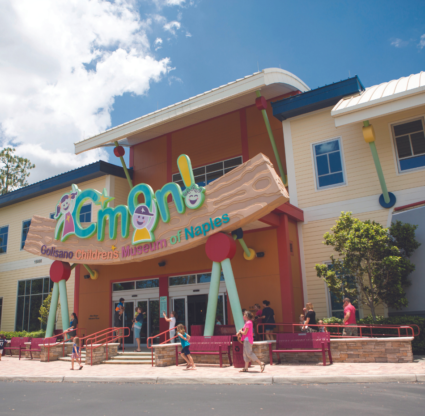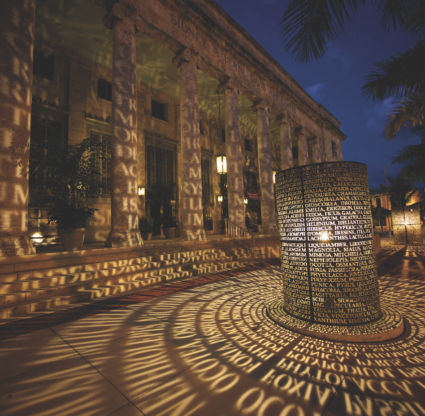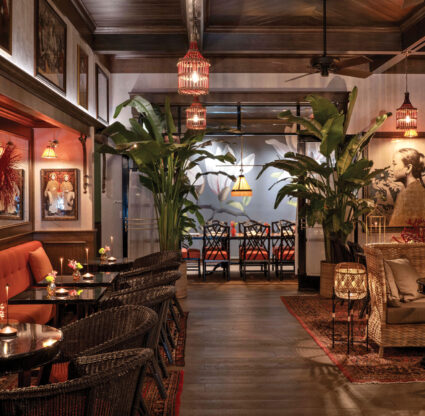As Yogi Berra once said, prediction is difficult, especially about the future. But it’s starting to look as if a generational shift in leadership is taking place at art museums and galleries around South- west Florida. And the eventual upshot is likely to be the creation of an art scene more vibrant and cosmopolitan in flavor than in the past.
Perhaps the most striking example can be seen at The Baker Museum at Artis—Naples. There, 40-year-old Frank Verpoorten is entering his third year at the helm of the region’s only full-fledged art museum. Born in Belgium, he came to the museum with 15 years of experience as a curator and cultural attaché in New York City and Brussels. He brings a European sensibility and broad knowledge of art to the task of shaping the museum’s identity. This season, he’s organized an exhibition centered on René Magritte, surely the most celebrated Belgian artist of the 20th century. The Discreet Charm of the Bourgeoisie: Magritte and the Belgian Surrealists opens at The Baker Museum on Jan. 31.
And, in the design district that has grown up along 10th Street South in downtown, Naples, Detroit transplant Chad Jensen has developed a gallery that synergizes contemporary art and fine craft. Jensen, 37, is equally happy to show you an exquisite, hand-blown glass vessel as a high-style abstract painting that will look smashing over your midcentury modern couch. This enterprising little gallery, called Thomas Riley Studio, opened a year ago. It’s an offshoot of Thomas Riley Artisans’ Guild, a high-end woodworking and furniture business with deep roots here. Jensen has lined up an intriguing slate of shows for the current season, ranging from glossy abstract paintings in resin by German artist Peter Zimmermann to otherworldly photographs by New Yorker Kim Keever, who stages dramatic, colorful scenes in a 200-gallon water tank in his studio.
Sister Act
Change is also in the air at Harmon-Meek Gallery in Naples, where the two daughters of William and Barbara Meek are bringing fresh energy to the family business. Juliana Meek, 33, and Kristine Meek, 36, began assuming the direction of this longtime Naples institution in January 2014. While still relying on their parents for guidance, they are increasingly putting their stamp on the operation, which opened just over a half-century ago as the Foster Harmon Gallery. The elder Meeks purchased the gallery in 1978, 10 days before Kristine was born, and renamed it Harmon-Meek. Now, over a 10-year period, their daughters are buying the gallery from them.
“My sister and I want to value the past,” Kristine says. “We’re going back to our roots, but with a twist,” Juliana notes. The two both went to college at Drake University in Iowa, but big sister Kristine is quick to point out that she went there first.
So far, the pair has instituted several relatively low-profile initiatives, like acquiring certification as a green business. And they’ve begun a recognition program, Visionaries of the Visual Arts, which honors three individuals annually and raises funds for children’s charities. This year’s honorees are arts supporters Raymond Staffeldt, Mary Wasmer and Richard Tooke.
The big news, however, is that the two are behind a gallery expansion. Harmon-Meek modern (the lowercase “m” is intentional), opens this month in a newly constructed building at 382 12th Ave. S. in Naples, with Juliana as director. The gallery’s current location on U.S. 41 will remain Harmon-Meek Gallery, with William Meek as director and Kristine as assistant director. The new 2,400-square-foot space will allow the Meeks more room to show works by the 45 artists and artist estates they represent—Robert Vickrey, Hunt Slonem, Robert Kipniss and Richard Segalman among them.
Having grown up in the gallery business, Juliana and Kristine are keenly aware some of their clients see them as tots or teenagers who held the door at receptions. “Some people still prefer to talk to Dad. He’s still very much part of the business,” Kristine notes. “But we can be more approachable for women,” Juliana adds, and they hope to grow a new generation of art collectors among their peers as well.
“Our parents always told us, ‘You can be anything you want to be—just not an art dealer,’” Juliana says. Both cultivated careers outside the arts before coming back to Naples a few years ago. After college, Kristine moved to Chicago and took a job at the Shedd Aquarium. “I was an aquarist, an animal keeper. I was one of those people in a wetsuit who go in the tank with the sharks,” she notes (which, in retrospect, sounds like pretty good training for an art dealer). She then earned an M.B.A. at DePaul University and went on to work in fund- raising and development for the African Wildlife Foundation and The Conservancy Fund in Washington, D.C.
Juliana studied computer science at Drake and went on to law school there. Upon graduation, she was recruited by the government and spent six years working at the CIA as a cyber threat intelligence analyst. (Now, Kristine likes to say her sister’s CIA experience makes it easier to read clients and figure out what they want.)

John Loscuito and Jade Dellinger
Cautious Risk-Taker
John Loscuito’s job is like the keeper of animals at an exotic game preserve. He arrived in Florida a year ago to become gallery director at Florida Gulf Coast University in Estero, which had been without a permanent individual in that position for five years. And he has begun—ever so carefully—to change things up a bit.
Loscuito, 39, was the registrar at Marquette University’s Haggerty Museum of Art in Milwaukee for seven years prior to moving to Florida. He used some of that time to earn an M.B.A. degree from Marquette, on top of the M.F.A. he’d already received from the University of Wisconsin-Milwaukee.
He expected Southwest Florida to be a conservative place artistically, but found that not to be the case. “I think it’s a place that’s on the move,” he says. He discovered a thriving local art scene and colleagues at other institutions willing to collaborate with him. “The more we have an open dialogue, the more the landscape will continue to shift, and we’ll look outward as well as inward,” he says.
Last fall, Loscuito offered an inkling of his curatorial leanings with an exhibit called Possibility of Function. It surveyed the work of Yevgeniya Kaganovich.
Her installations are complex and allusive. Sculptural objects are conceived as bodily attachments. They resem ble scientific or medical devices and look as if they might have a reason to exist—in other words, that they might function. Ranging in size from small, individual “mouthpieces” made of cast rubber and other materials to a pair of large weather balloons with dangling respirator-like attachments, her sculptures evoke feelings of absurdity, futility and, lately, fears of contagion. The point is, her artwork is about the embodiment of ideas. It is not necessarily easy to understand or to take in at a glance. You might find it puzzling, unattractive or perhaps not even think it is art.
“Being at a university, you are some- what protected,” Loscuito says, with his own gallery in mind. “It’s supposed to be a center for research and experimentation and thought-provoking exhibits.”
Since his arrival, Loscuito has begun an artist-in-residence program at FGCU’s Vester Marine Field Station in Bonita Springs, just off Bonita Beach Road on Little Hickory Island. “I thought it would be great to bring an artist there, especially an artist interested in the sciences, to think and work,” Loscuito says. The inaugural resident, Tampa-area painter and sculptor Joe Griffith, will be there for the first half of this month, pondering the effects of mercury contamination on shellfish.
At the same time, Loscuito and gallery coordinator Anica Sturdivant are preparing a quietly provocative exhibition that opens Jan. 15 in the university’s Main Gallery. Called Belonging, the show touches on the complex and many-sided meanings of “home.” Particularly in Southwest Florida, where the population is more transient than most, what does it mean to belong to a place? What is the meaning of home at different points in our lives? What sort of baggage do we lug from place to place, or leave behind?
Three artists who were born else- where but now live in South Florida ad- dress these questions in different ways. Noelle Mason’s work deals with discomforting themes of border crossings, immigration and surveillance. Kendra Frorup creates sculptures that evoke the textures and sensory experiences of her childhood home in the Bahamas. Amalia Caputo’s photographs and videos dwell on the power of objects, suggesting how mundane possessions can be infused with memories and desires.
“If artists hold up a mirror to these issues—and if that can be balanced with craft and poetics—then you have this magic moment,” Loscuito says.
What Would Bob Do?
Jade Dellinger is given to bold and unconventional strokes. After two decades as an independent curator, Dellinger, 46, came on board in September 2013 as director of the Bob Rauschenberg Gallery at Florida SouthWestern State College (formerly Edison State College) in Fort Myers. But he operates according to a different playbook than most college gallery directors, who are trying to please a constituency with wide-ranging aesthetic interests.
“I felt like this was such a special place, with the history and the connection to Robert Rauschenberg. When this opportunity came along, it was too good to pass up,” he explains.
For years, he’d shuttled between New York City and the Tampa area, organizing art projects for the University of South Florida’s Contemporary Art Museum and other institutions. His involvement with major artists such as Allan McCollum, Maurizio Cattelan, Ann Hamilton and Andrew Deitch had taken him across America and around the globe, to places like Mexico City and Tblisi, Georgia.
But in fall 2013, Dellinger found himself in charge of a gallery without any art on the walls. The previous director, Ron Bishop, had retired in June after 14 years, without planning an exhibition schedule for the 2013-14 school year. “It was a blessing and a curse,” Dellinger says. He could put his own vision into place immediately. On the other hand, there were those empty walls.
Dellinger decided to reopen with a bang in January 2014. He tapped his network and found his wow factor—a traveling show of interactive works by conceptual artist Yoko Ono that was just returning from an international tour.
However, the connection to the world-famous Robert Rauschenberg, who lived in Captiva Island from 1971 until he passed away in 2008, holds the greatest sway on Dellinger.
“We have a responsibility to do things that are Rauschenberg-related. I feel strongly that we should be having an annual Rauschenberg show” or one that illuminates the artist’s continuing influence in today’s art world, Dellinger observes. “I think it’s about being true to his interests and philosophy, and exploring his impact on contemporary art.”
In the fall, the gallery hosted a lecture by the brilliantly roguish art critic Dave Hickey, who discussed Rauschenberg’s importance as a “giver of permission” for artists to explore the outer limits of their creativity. And the season-opening show, Rauschenberg: China/America Mix, featured a single, wrap-around, 100-foot-long photograph called Chinese Summerhall, made by collaging together 52 images Rauschenberg took during a pioneering cultural exchange trip to China in the early 1980s.
Dellinger’s intense focus on the legacy of one artist is a bracing sign of change. And, as he and his colleagues across the region bring fresh influences, ideas and openness to art currents elsewhere in the country and around the globe, one thing is certain: Predicting our art world will stay the same is a prediction sure to be wrong.





